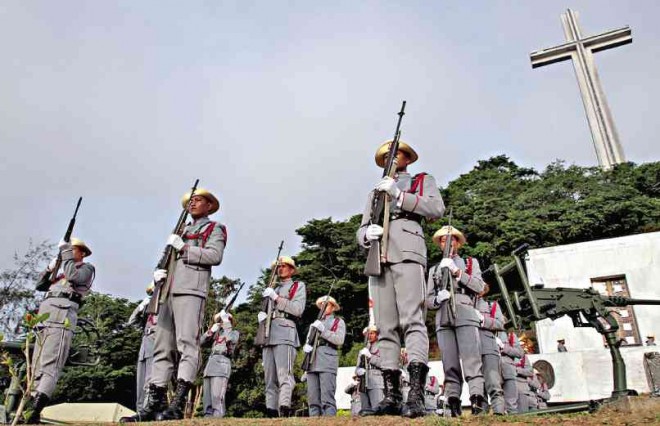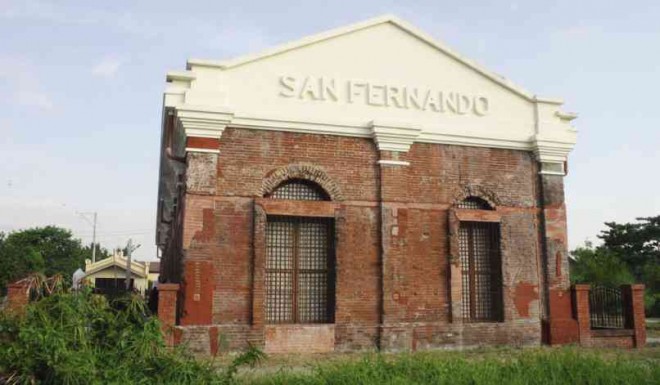Grim reminders of Filipino heroism

THE DAMBANA ng Kagitingan (Shrine of Valor) on Mt. Samat in Pilar, Bataan, honors the country’s war heroes. INQUIRER PHOTO
TOURS OF WORLD WAR II battle sites and memorials in Central Luzon, while aplenty, are not year-round activities in the region. These are, in fact, “seasonal,” according to Ronaldo Tiotuico, regional director of the Department of Tourism (DOT).
“The travels are confined mostly in March onwards to April 9 [for a reenactment of the surrender of Bataan or Araw ng Kagitingan rites],” Tiotuico says.
The route begins where the harrowing march of more than 70,000 Filipino and American soldiers started on April 10, 1942 at Kilometer Zero in Mariveles town and on April 11 in Bagac town, both in Bataan province, then to a train station in the City of San Fernando in Pampanga province, where they were loaded onto cramped freight cars, and finally at the Capas National Shrine in Tarlac province, former site of a concentration camp where more soldiers died of starvation and diseases. The Death March route from Bataan to Pampanga covered 102 kilometers.
Americans and Japanese—either descendants of soldiers or history enthusiasts—often visit these sites, Tiotuico says. The DOT refers them to tour operators who provide technical knowledge on World War II routes and memorials.
Ten of the operators specialize on these journeys, getting 50 to 100 tourists a month. The number excludes those who do not coordinate with DOT or travel operators.
Article continues after this advertisementDeath March route
Article continues after this advertisementBut the Bataan Death March route could be enriched, Tiotuico says. A trip to the Dambana ng Kagitingan (Shrine of Valor) on Mt. Samat in Barangay (village) Diwa in Pilar town, Bataan, gives the traveler an overview of how Filipino and American soldiers defended Bataan as the last stronghold of freedom from invasion. Its 92-meter tall Memorial Cross, colonnade and museum feature sculptures and objects that help relive the courage and sacrifices of soldiers.

THE SAN FERNANDO train station in Pampanga served as the ending point for the Death March. E.I. REYMOND T. OREJAS/CONTRIBUTOR
The Bataan provincial government suggests several sites, with a list found in its website (www.bataan.gov.ph). These include the Surrender Site marker, consisting of six life-size figures of men on the grounds of Balanga Elementary School in Balanga City.
The sculptures froze in time an event in what was then used as a command post by Lt. Gen. Masaharu Homma when Bataan surrendered. Maj. Gen. Edward King and his party signed the documents for the surrender of the US Armed Forces in the Far East (Usaffe) in the Philippines on April 9, 1942.
Joining the Araw ng Kagitingan ultramarathon can be for the more physically fit tourists. Ed Paez and Safer Run organized this event 30 years ago as a tribute to veterans.
Add to the itinerary a visit to Clark Cemetery along the Mitchell Highway at Clark Freeport. Established by the US Air Force in 1950, the cemetery has 12,000 graves that date back to 1900, mostly relocated from Fort McKinley that later hosted the final resting place of those who died in World World II.
While in Clark, drop by Capt. Colin Kelly Shrine. Kelly led the attack on the largest Japanese ship Ashigara off the coast of Luzon three days after the Japanese assault on Pearl Harbor in Hawaii on Dec. 7, 1941.
At Lily Field is a 4.57-meter Kannon Bodhisattva or the Goddess of Mercy Shrine. At West Air Field is a shrine for Kamikaze or Japanese suicide pilots. Just outside Clark, in Barangay Cacutud, is a Kamikaze pilot statue on an elevated pedestal secured by a Tori gate.

A MONUMENT at the Clark Cemetery in Clark Freeport pays tribute to Filipino and American soldiers who fought against Japanese soldiers during World War II. E.I. REYMOND T. OREJAS/CONTRIBUTOR
The Mabalacat government built these memorials to highlight the role of the town in war and peace, Mayor Marino Morales said.
In Barangay Navy in Capas, the Capas National Shrine features an obelisk and a memorial wall showing the names of soldiers who died in the camp. There is a smaller memorial for Czech nationals who fought with Filipinos and Americans.
The Battling Bastards of Bataan honor their comrades through a small museum and mini-monument. Relics of an old train and tracks that brought the Death March survivors to Capas are installed in this shrine.
In Cabanatuan City in Nueva Ecija province, the Camp Pangatian Shrine celebrates what is described as the most daring and successful rescue of 516 prisoners of war, mostly survivors of the Death March, on Jan. 30, 1945.
The triumph of the human spirit and the love for freedom and peace are the themes that resonate in these walk-back in time, Tiotuico says.